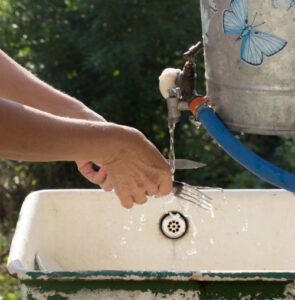
South Africans Are Inventing New Ways to Capture Every Drop
Across the Eastern Cape and KwaZulu-Natal, rain is treated with careful attention. In towns where water shortages and supply interruptions are part of life, rainfall is not simply a background event, it is something to be noticed, measured, and stored. Over the past few years, a quiet culture of invention has taken hold in these communities. Individuals have begun creating homemade rainwater harvesting systems using scrap materials, recycled containers, and whatever else they can find. These are not official projects or branded solutions. They are one-person efforts, crafted in backyards, on rooftops, alongside spaza shops, and behind township betting kiosks.
The designs are often simple yet effective. In Butterworth, for instance, it is common to see makeshift systems built from old satellite dishes, plastic drums salvaged from building sites, and lengths of piping collected over time. Each setup is unique, tailored to fit the available space and resources. The materials are sourced locally, often pulled from items no longer in use, broken kiosks, old lottery ticket trays, unused building supplies. These systems serve more than just the homes they are attached to. In many cases, they support neighbouring families as well, with collected water shared for cooking, washing, and cleaning.
This grassroots approach to rainwater harvesting is driven by necessity. Water cuts can last for days in some areas, and tanker deliveries are not always reliable. Rather than waiting for municipal services to fill the gap, residents have taken it upon themselves to create small-scale solutions. These homemade systems may not look polished, but they function as intended. Even a light drizzle can fill a tank over time, providing a degree of independence that is deeply valued in regions where utility services are unpredictable.
Across South Africa, variations on this practice can be found. In Umlazi, families rig up collection systems using corrugated iron sheets, paddling pools, and sealants sourced from street markets. These setups are often patched together through trial and error, refined until they work. Young people, particularly those with technical college training, have joined in as well. In towns like Port Shepstone, students have constructed hybrid systems that combine rainwater collection with basic purification. Using parts from old appliances such as washing machine drums and kettle elements, they create functional, low-cost systems for family and neighbours.
While these inventions are born from practical needs, there is also a quiet sense of pride in their creation. Communities share advice, compare designs, and sometimes compete informally to see who can collect the most water with the simplest setup. This culture is not about large-scale sustainability projects, it is about addressing everyday needs with resourcefulness and determination. When pipes leak or tanks break, repairs are made immediately using wire, sealant, or spare materials. There is no waiting for official repairs. Maintenance is part of the rhythm.
The presence of these rain-harvesting systems is woven into the fabric of local life. They are not limited to private homes. Small businesses, including betting kiosks and spaza shops, often have their own water collection setups. Some shop owners use the water to clean pavements or maintain a tidy storefront, which in turn keeps customers coming back. In all cases, these systems serve as quiet reminders of how people adapt to their environment when services fall short.
 These solutions are not perfect. Tanks crack. Structures fall during storms. Yet each time, they are rebuilt. There is a consistent drive to keep the system working, to maintain that small but vital supply of water. It is not about waiting for rain with idle hope. It is about being ready for it and capturing every drop when it comes.
These solutions are not perfect. Tanks crack. Structures fall during storms. Yet each time, they are rebuilt. There is a consistent drive to keep the system working, to maintain that small but vital supply of water. It is not about waiting for rain with idle hope. It is about being ready for it and capturing every drop when it comes.
This form of everyday innovation is not often documented or recognised. There are no product labels, no corporate sponsorships. Yet across rooftops and backyards in South Africa, these homegrown inventions form a visible sign of resilience. They represent a practical response to changing weather patterns and municipal challenges, one bucket, one pipe, one recycled drum at a time.
For the individuals maintaining these systems, it is not about technology for its own sake. It is about having water for basic needs, washing, cooking, cleaning, without relying entirely on outside services. These rain-harvesting setups stand as a quiet but significant part of South African life, particularly in areas where infrastructure does not always meet daily demands.
When rain does fall after a long dry stretch, it becomes more than a relief. It is an earned reward for effort already made. Each collected litre is a measure of preparation and care, a reflection of small, practical actions taken by individuals and communities determined to manage their needs in their own way.




